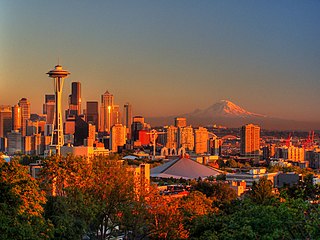
Peter Steinbrueck is an American architect and politician from Seattle, Washington. He is the principal and founder of Steinbrueck Urban Strategies and was a member of the Seattle City Council from 1997 to 2008. He also was a Seattle Port Commissioner from 2018 to 2022.

Victor Steinbrueck Park is a 0.8 acre park in Downtown Seattle, Washington, United States, located just northwest of Pike Place Market overlooking Elliott Bay. Named for the Seattle-based architect Victor Steinbrueck, it is positioned between Western Avenue and Alaskan Way at the foot of Virginia Street.

Franklin High School is a public high school in Seattle, Washington, located in its Mount Baker neighborhood and administered by Seattle Public Schools.

Lionel H. ("Spike") Pries, was a leading architect, artist, and educator in the Pacific Northwest.
Roland Terry was a Pacific Northwest architect from the 1950s to the 1990s. He was a prime contributor to the regional approach to Modern architecture created in the Northwest in the post-World War II era.

Paul Hayden Kirk was a Pacific Northwest architect. Paul Kirk's designs contributed to development of a regionally appropriate version of Modern architecture. Many of his buildings are as much appreciated today as they were at the time they were built.
Jeffrey Karl Ochsner is an architect, architectural historian, and professor at the University of Washington in Seattle. He is known for his research and writing on American architects Henry Hobson Richardson and Lionel H. Pries, and on Seattle architecture; he has also published articles that link architecture and psychoanalysis.

The Hoge Building is a 17-story building constructed in 1911 by, and named for James D. Hoge, a banker and real estate investor, on the northwest corner of Second Avenue and Cherry Street in Seattle, Washington. The building was constructed primarily of tan brick and terracotta built over a steel frame in the architectural style of Second Renaissance Revival with elements of Beaux Arts. It was the tallest building in Seattle from 1911 to 1914, until the completion of Smith Tower.

The College of Built Environments is the architecture and urban planning school of the University of Washington, a public research university in Seattle, Washington.
Victor W. Voorhees (1876–1970) was an American architect most active in Seattle, Washington. He is credited with the design of over 110 building projects. Considered one of the Northwest's finest designer of garages, he was responsible for a large number of automobile related buildings built on Capitol Hill in the 1910s and 1920s, Seattle's original auto row. His residential plan book, Western Home Builder, which went through six editions between 1907 and 1911, provided templates for popular local house designs like the Seattle box.

The Blackstone Apartments are located at 222 Summit Ave East in the Capitol Hill neighborhood of Seattle, Washington, United States. The apartment complex was designed and owned by J.S. Long and built by the Long Building Company in 1927. The Long Building Company was known for designing and building many of the Bungalow-style homes, particularly in the First Hill neighborhood of Seattle under the guidance of Stanley Long. The building consists of 26 units with a mixture of 2-, 3-, 4-, and 6-room suites; it has a brick exterior with a great deal of mahogany woodwork in the interiors and built-ins throughout the units, and was originally fitted with Monarch electric stoves and Frigidaires. The complex was "regarded as one of the most modern units of its kind in the city" when it was completed.

University Unitarian Church was designed by Seattle architect Paul Hayden Kirk in 1959. The church is located in the Wedgwood, Seattle neighborhood at the corner of 35th Avenue NE and 68th Street. The building is approximately a mile and half Northeast of the University of Washington Campus and sits across from the Northeast Branch of the Seattle Public Library. It was designed during the time when architect Kirk was working as a sole practitioner.

The architecture of Seattle, Washington, the largest city in the Pacific Northwest region of the U.S., features elements that predate the arrival of the area's first settlers of European ancestry in the mid-19th century, and has reflected and influenced numerous architectural styles over time. As of the early 21st century, a major construction boom continues to redefine the city's downtown area as well as neighborhoods such as Capitol Hill, Ballard and, perhaps most dramatically, South Lake Union.

The Skinner Building is an eight-story building in Seattle, in the U.S. state of Washington, which includes the historic 5th Avenue Theatre at its southern end. Part of the Metropolitan Tract, the structure is listed on the National Register of Historic Places for the architecture of the interior theatre and of the rest of the building. The exterior features an unadorned sandstone facade with a false loggia and red mission tile roof.

John Theodore Jacobsen was an American architect active in the Pacific Northwest and Hawaii. Born in Seattle, Jacobsen studied architecture at the University of Washington and the University of Pennsylvania during the early 1920s. He traveled to the Soviet Union in 1926, where he designed several schools, before embarking on travels in Europe, South America, and Africa. He studied fresco painting in France before returning to the United States, where he worked for a period at architectural firms in New York City and at Colonial Williamsburg. Returning to Seattle in 1932, he designed bas-relief murals before becoming an instructor at the University of Washington and beginning private practice.
William Aitken was a Scottish-American architect. Born in Glasgow, he attended school in Scotland before emigrating to Vancouver, Canada, before 1911. He crossed into the United States around 1915 and became a dock engineer for the Pacific Coast Company in Seattle. In 1919, he received his architecture license and began private practice, designing various buildings across western Washington from the 1920s to the early 1960s. Among his major works are Sick's Stadium, the host stadium of the Seattle Rainiers, and Yesler Terrace, Seattle's first public housing development, which was designed in collaboration with various other architects. Aitken retired in 1960 but continued working on some smaller projects, including the Captain's Table Restaurant for restaurateur Ivar Haglund. Some forty-five years after first immigrating to the United States, he received his American citizenship in 1961, shortly before his death of cancer in July of that year.

George Wellington Stoddard was an American architect. Born in Detroit, he graduated from the University of Illinois shortly before being drafted into the American Expeditionary Forces in 1917. Upon his return to the United States, he traveled to Seattle and founded the architecture and construction firm Stoddard and Son with his father. After building a variety of residential and commercial structures together, his father died in 1929, and Stoddard continued private practice under his own name. During his early career he mainly designed buildings according to the popular Moderne architectural style, but shifted towards a more experimental Modernist approach, especially after World War II.

Ibsen Andreas Nelsen was an American architect and urban planner active in the Pacific Northwest. He was born to a Danish immigrant family in Ruskin, Nebraska, which fled west during the Dust Bowl and settled in Medford, Oregon. After serving in the Pacific during World War II, he received his Bachelor of Architecture from the University of Oregon in 1951. He moved to Seattle, where after working for several smaller firms he began his own practice in 1953. He partnered with Russell Sabin shortly afterwards, with Gordon Bennett Varey joining the firm in 1961 to form Nelsen, Sabin, & Varey. With the firm, Nelsen designed projects such as the home of painter Morris Graves in Loleta, California.

Albert Orin Bumgardner was an American architect. Born in Springfield, Illinois, he attended the Illinois State University in Normal before serving in the United States Army Air Corps during World War II. After the war, he studied architecture at the University of Illinois, where he graduated in 1949. He moved to Seattle, where he worked at various firms before beginning his own practice in early 1953. He gained acclaim from architecture press and the American Institute of Architects for a number of house designs. His firm, Bumgardner Partnership, gained further notability following their office design for the periodical Pacific Architect & Builder; this led to institutional contracts that saw Bumgardner lead design projects at Evergreen State College and the University of Washington. He oversaw designs for a number of projects along the Seattle Waterfront during the 1970s and 1980s, including Waterfront Park and the Watermark Tower.
Victor Noble Jarrott Jones was a Canadian-American architect. Born in Exeter, Ontario, he immigrated to Seattle with his parents and attended the University of Washington, graduating in 1924. After receiving his Master of Architecture from the University of Pennsylvania in 1926, he worked for a number of local architects before returning to Seattle to work for the firm of Edward Pinneh and Robert F. McClelland. He left the firm to partner with J. Lister Holmes, and worked together with Carl Frelinghuysen Gould to design the Washington State Pavilion at the 1939 New York World's Fair. He founded an independent practice in 1942; over the late 1940s and 1950s, he designed a number of projects in Idaho, as well as campus buildings for the University of Washington and Washington State University. He designed the Overlake Memorial Hospital and the Seattle Ferry Terminal, both ultimately constructed after his retirement in 1959.














